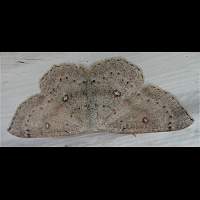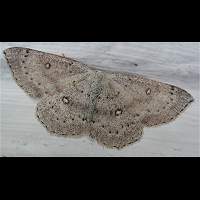Birch Mocha (Cyclophora albipunctata)
If well marked the Birch Mocha is unmistakable. Less marked animals may often be identified by their light basic colour: white or greyish. But many animals, especially those of the 2nd generation are much darker and may look like the Dingy Mocha. The latter is a very rare Red Book species though. Experts tell the two species apart by examining the shape of the wings. The Birch Mocha reaches a wingspan of 25 to 29mm.
Most eggs are being laid in May, June and early July. The eggs hatch quickly and we see caterpillars crawling about from June to October. These pupate and it is the pupa that overwinters. Pupae are attached to leaves or small twigs. In Southern Britain the species has two generations. The caterpillars of the Birch Mocha come in two colours: they are either green or grey. In both cases the head is brown. The caterpillars grow to a length of 20 to 23mm. Like the animal's name suggests the only known foodplant is the birch.
In Northern Britain, especially in Scotland, there is one generation only, on the wing in July and August. In Southern Britain the Birch Mocha is double-brooded, usually in two distinct generation. The first is on the wing in May and June, while the second appears in August mainly. The species is quite active and occassionally flies by day visiting flowers, preferring thistles. May also easily be disturbed by day. At night it does visit flowers, including those in gardens and is attracted to sugar. Also comes to light readily. Very common in Southern and Eastern England. A local species elsewhere in England and in Wales. Common in Scotland, but rather uncommon in Ireland. Prefers sandy soils. Common in much of Europe, but a rather local species in some parts.
If well marked the Birch Mocha is unmistakable. Less marked animals may often be identified by their light basic colour: white or greyish. But many animals, especially those of the 2nd generation are much darker and may look like the Dingy Mocha. The latter is a very rare Red Book species though. Experts tell the two species apart by examining the shape of the wings. The Birch Mocha reaches a wingspan of 25 to 29mm.
Most eggs are being laid in May, June and early July. The eggs hatch quickly and we see caterpillars crawling about from June to October. These pupate and it is the pupa that overwinters. Pupae are attached to leaves or small twigs. In Southern Britain the species has two generations. The caterpillars of the Birch Mocha come in two colours: they are either green or grey. In both cases the head is brown. The caterpillars grow to a length of 20 to 23mm. Like the animal's name suggests the only known foodplant is the birch.
In Northern Britain, especially in Scotland, there is one generation only, on the wing in July and August. In Southern Britain the Birch Mocha is double-brooded, usually in two distinct generation. The first is on the wing in May and June, while the second appears in August mainly. The species is quite active and occassionally flies by day visiting flowers, preferring thistles. May also easily be disturbed by day. At night it does visit flowers, including those in gardens and is attracted to sugar. Also comes to light readily. Very common in Southern and Eastern England. A local species elsewhere in England and in Wales. Common in Scotland, but rather uncommon in Ireland. Prefers sandy soils. Common in much of Europe, but a rather local species in some parts.





